Rare Half Dollars: Coins of Your Dreams
Posted onHalf dollars, America’s 50-cent coins, were introduced in 1794. Since then, they have seamlessly integrated into the nation’s currency, today holding a cherished place in collectors’ hearts. From the classic elegance of the Walking Liberty to the symbolic Franklin and Kennedy designs, each coin serves as a poignant representation of distinct eras. This article will discuss rare half dollar coins worth money, delving into:
- The reasons for their rarity.
- The most valuable half dollars.
- Where to find these sought-after pieces.
For a comprehensive list of the most valuable rare half dollar coins, watch this insightful video:
Why are half dollar coins rare?
Over time, half dollars have evolved into captivating treasures for coin collectors, valued not just for their visual appeal but also for their rarity. Gaining an understanding of the factors that contribute to this rarity is essential for deepening one’s appreciation of these coins.
- Mintages and Production Changes: The rarity of certain half dollars can be traced back to limited mintages and significant production changes over the years. For instance, early issues like the 1794 Flowing Hair Half Dollar had minimal mintage due to the challenges of coin production during that era. Similarly, shifts in coin designs, such as the transition from the Franklin Half Dollar to the Kennedy Half Dollar in 1964, marked distinct periods of production change, influencing the scarcity of specific issues.
- Historical Events and Melted Silver: Several historical events have played a pivotal role in the scarcity of half dollars. During times of economic uncertainty or wars, coins were often melted down for their silver content. The Silver Act of 1963, which led to the elimination of silver from most circulating coins, further impacted the availability of silver half dollars. As a result, coins from these periods are now scarce, with many lost to melting or removal from circulation.
- Hoarding: Intriguingly, half dollars have faced a unique fate at the hands of coin collectors. As certain issues gained recognition for their rarity, a phenomenon of hoarding emerged. Savvy collectors, aware of the potential future value, began accumulating specific half dollars, leading to reduced availability in the market. This deliberate act of preservation has contributed significantly to the scarcity of these coins, creating a fascinating aspect of numismatic history.
- Condition and Survival Rates: The preservation and survival rates of half dollars also play a crucial role in their rarity. Factors such as exposure to harsh environmental conditions, circulation wear, and mishandling impact the overall availability of well-preserved coins. As collectors increasingly prioritize coins in excellent condition, finding rare half dollars in pristine state becomes a greater challenge, elevating the rarity of high-grade specimens.
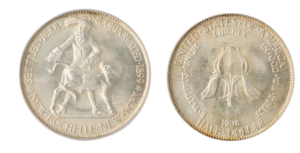
1938 New Rochelle Silver Commemorative Half PCGS MS66
How rare is a half dollar coin?
The rarity of half dollar coins is highly contingent on factors such as type, historical context, and public reception. Initially introduced in 1794, these coins have been in circulation since the early days of the U.S. Mint and can be categorized by their different designs. These include the early half dollars, namely Flowing Hair, Draped Bust, and Capped Bust, followed by the Seated Liberty, Barber, Walking Liberty, and, lastly, Franklin and Kennedy half dollars. Today, commemorative half dollars contribute to this diverse landscape, featuring unique designs commemorating significant events.
As coin connoisseurs will know, the rarity of half dollar coins varies significantly among the different designs. Early half dollars tend to be rarer due to their age and historical significance:
- Seated Liberty and Barber designs, while still having historical value, are more accessible.
- Walking Liberty and Franklin half dollars, with their appealing designs, strike a balance between rarity and availability.
- The Kennedy half-dollar, introduced in 1964, stands out as one of the most prevalent variants, but its silver content from 1965 to 1970 contributed to its removal from circulation by hoarders. Despite being actively produced, Kennedy halves have encountered difficulties gaining modern public acceptance due to their size and merchants’ reluctance to handle them in transactions. This has contributed to their diminished use and perception of rarity as rare half dollar Kennedy coins.
- Commemorative half dollars are deliberately designed for collectors and not intended for general circulation, contributing to their inherent rarity. Some stand out as exceptionally rare, such as the 1921 Alabama Centennial half dollar.
For more information on the question “How rare is a half dollar coin?” and other pieces, consult Blanchard’s rare coins guide.
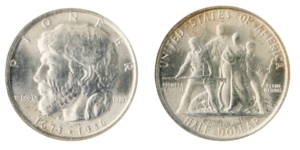
1936 Elgin Half Dollar NGC MS66
Rare half dollar coin: value for collectors and investors
Within the extensive history of half dollars, these are some stand-out pieces that have etched their mark in the world of numismatics.
1806/5 Draped Bust: a rare half dollar coin
As collectors marvel at this coin, the question naturally arises: “How rare are half dollar coins?” The 1806/5 Draped Bust Half Dollar stands as a numismatic marvel. As indicated by the absence of a mintmark on the coin, it was produced at the Philadelphia Mint with a mintage of 839,576. Its obverse and reverse design, featuring the Liberty Draped Bust, was created by Robert Scot, the Chief Engraver of the United States Mint during that period.
1806/5 Draped Bust Half NGC AU58 CAC
- Metal: Silver
- Year: 1806
- What makes this coin special: This particular specimen is set apart by its overdate feature, i.e. the digit “6” struck over a “5,” resulting from repurposing leftover dies from 1805. Beyond its minting anomaly, the coin’s well-preserved ‘Almost Uncirculated’ grade and the coveted CAC seal of approval elevate its desirability.
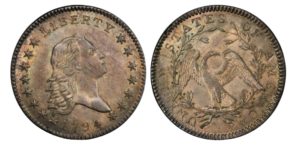
When it comes to rare half dollar coins (1776 to 1976), it is clear that this 1806 gem stands out and you can learn more about it here.
1861 Confederate States of America Restrike: one of the most unique half dollar rare coins
The answer to the question “Are half dollar coins rare?” is clear as far as the 1861 50C Confederate States of America Restrike is concerned. An extraordinary relic from a tumultuous period in American history, this coin was originally crafted during the Civil War by the Confederate States, a testament to their brief venture into minting currency. The obverse, borrowing from the United States Half Dollar, features a Liberty Cap above a shield adorned with seven stars and stripes representing the seceded Southern states.
1861 50C Confederate States of America Restrike NGC MS66
- Metal: Silver
- Year: 1861
- What makes this coin special: The coin’s captivating history contributes to its scarcity. The coin was first minted in very limited numbers, with only four of the original pieces documented, each gifted to notable figures like President Jefferson Davis. With the later restrike of the coin, which marked a numismatic milestone, it entered the collector’s realm. The NGC MS66 grade of this specimen, signifying exceptional preservation, further contributes to its desirability.
- Get our most current price here.
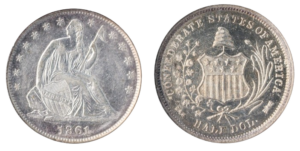
1907 Barber: one of the most sought-after rare US half dollar coins
Answering the question “Are half a dollar coins rare?” would not be complete without mentioning the 1907 Barber Half Dollar. It bears an elegant design by Chief Engraver Charles E. Barber, with Lady Liberty wearing a Phrygian cap gracing the obverse and the reverse showcasing an eagle clutching an olive branch and arrows. Struck at the Philadelphia Mint, it holds historical significance as the last year of the Barber Half Dollar series.
1907 Barber Half Dollar PCGS PR65 CAC
-
- Metal: Silver
- Year: 1907
- What makes this coin special: This coin captivates collectors with its scarcity of high-grade specimens, stemming from irregular minting quality. The irregularities in minting, ranging from striking pressure to planchet preparation, led to variations in surface conditions and details on the coins. These variations contribute to the coin’s allure, as collectors seek specimens that showcase the best possible craftsmanship despite the challenges faced during minting.
- View our most current price here.
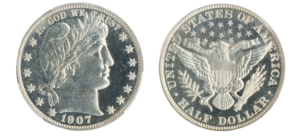
To delve deeper into the question “Why are half dollar coins rare?”, read about Barber Halves here.
1794 Flowing Hair Half Dollar: one of the most special rare half dollar coins
The 1794 Flowing Hair Half Dollar represents the first year of the denomination, which makes this early American half dollar coin rare. Inspired by the Spanish dollar in terms of size and weight, the coin was designed by Robert Scot. Its obverse captures Liberty’s bust, encircled by fifteen stars denoting the ratified states, while the reverse presents a majestic eagle surrounded by a wreath.
1794 Flowing Hair Half Dollar
-
- Metal: Silver
- Year: 1794
- What makes this coin special: With a mintage of merely 23,464 pieces, i.e. less than a tenth of the mintage of the following year, the limited circulation of this coin is part of the reason why the 1794 Flowing Hair Half Dollar is considered very rare. With only three coins in mint state and very few well-preserved examples, collectors eagerly vie for the chance to acquire them.

1971-D Kennedy: one of the most intriguing rare Kennedy half dollar coins
For many collectors seeking out rare half dollar coins, 1971 does not stand out as a particularly exciting year. However, the 1971 Kennedy half dollar stands as a captivating exception. Despite its more recent mintage, the 1971-D Kennedy Half, also referred to as 1971- D “No FG”, is a unique variety that captures the attention of savvy numismatists. Notably, this variety is missing the designer Frank Gasparro’s initials on the reverse of the coin, near the tip of the tail feathers of the eagle, due to a minting anomaly caused by a filled die. This oversight makes this coin distinct and particularly fascinating for Kennedy Half Dollar fans.
1971-D Kennedy Half Dollar
- Metal: Copper/nickel
- Year: 1971
- What makes this coin special: What makes this half dollar special extends beyond the missing initials. Its copper-nickel clad composition, distinct from earlier silver issues, adds to its allure, as it represents a transitional phase in coinage history. For knowledgeable enthusiasts, the extremely rare 1971-D mint Kennedy half dollar coin (collector’s item) is hard to resist
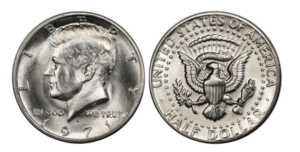
1928 Hawaiian Commemorative: one of the most unique rare half dollars coins
With respect to rare coins, half dollar commemoratives, issued to mark special events, hold historical and collectible significance. The 1928 Hawaiian Commemorative Half Dollar, celebrating the 150th anniversary of Captain James Cook’s arrival in Hawaii, stands out with its stunning design. Crafted by sculptor Chester Beach, it features the portrait of Captain James Cook on the obverse and a Hawaiian standing with a spear and cloak on the reverse.
1928 Hawaiian Commemorative Half Dollar
- Metal: Silver
- Year: 1928
- What makes this coin special: This coin provides a definitive “Yes” answer to the question “Is a half dollar coin rare if it’s commemorative?”. In contrast to some other commemorative coins of the era that were issued for speculative or commercial reasons, the 1928 Hawaiian Commemorative was created with the genuine purpose of honoring Captain Cook’s landing in the Hawaiian Islands. With a mintage of approximately 10,000, the coin was an instant hit, selling out swiftly for the price of $2 upon its release. Today, the coin’s rarity adds to its appeal.
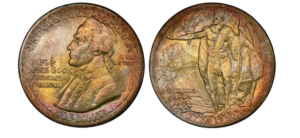
Where to buy rare US half dollar coins
In exploring this captivating realm of rare coins, one may naturally wonder, “Is the half dollar coin rare?”. As this piece has demonstrated, the answer is a resounding “yes”. Rare half dollars embody a rich tapestry of history and numismatic intrigue. From the overdated 1806/5 Draped Bust Half to the symbolic 1861 Seated Liberty Confederate States of America Restrike and the culturally significant 1928 Hawaiian Commemorative, each coin tells a unique story.
To navigate this captivating realm of rare coins, consider acquiring them from Blanchard. For insights into rare half dollar coin value and more, Blanchard team’s experts can offer trusted guidance to enhance your collecting journey.
Want to read more? Subscribe to the Blanchard Newsletter and get our tales from the vault, our favorite stories from around the world and the latest tangible assets news delivered to your inbox weekly.
What Are Some Rare Coins to Look for in Your Grandfather’s Collection?
Posted onThe pursuit of rare coins often involves a combination of exploration and networking. Coin shows, reputable dealers, auctions, and numismatic events can be excellent channels for acquiring unique, valuable pieces. While these avenues are fruitful, rare coins can also be serendipitously found closer to home, namely, within the confines of your family’s history! This article will explore what rare coins to look for in your forebears’ collections, discussing:
- The elements that make a coin rare.
- Rare US coins that can be found tucked away in your family’s heirlooms.
- Foreign rare coins to look out for within your family’s legacy trove.
Watch this video for a list of rare coins to look for: https://www.youtube.com/watch?v=x2ADkijyYmA
What to look for in rare coins
While a coin’s scarcity undoubtedly contributes to its value, it’s essential to note that valuable coins are not exclusively synonymous with rare ones. The rarity of a coin is determined by various attributes. These are the main elements that allow us to classify a coin as “rare”:
- Mintage numbers: Mintage plays a pivotal role in defining a coin’s rarity. When a coin is produced in limited quantities, it becomes inherently scarce. When it comes to what to look for in rare coins, it can generally be argued that the lower the mintage, the higher the likelihood that the coin will be deemed rare and sought after by collectors.
- Age: As coins age, their numbers naturally dwindle due to factors like wear, loss, or destruction. It is important to identify rare coin years to look for. Older coins, particularly those from historically significant periods, become increasingly scarce. Their limited availability over time contributes significantly to their allure among collectors.
- Grading: The condition of a coin is crucial in determining its rarity. Grading involves assessing a coin’s condition and preserving its quality. Numismatists rely on established grading systems to evaluate factors like wear, luster, and overall preservation. A higher grade signifies better condition, adding to a coin’s rarity.
- Varieties and errors: Coins with unusual variations in design or errors not found in the standard issues can be considered rare. Some examples of rare coins to look for include misprints, die breaks, or double strike errors. Collectors often seek these coins due to their distinctiveness.
- Demand: High collector interest in a particular coin can increase its perceived rarity, especially if the demand exceeds the available supply. Coins sought after for their historical significance, unique features, or cultural relevance often become rarer due to heightened demand, contributing to their overall value in the numismatic market.
Rare US coins to look for in your grandfather’s collection

Dedicated coin aficionados will, no doubt, be familiar with the Capped Bust Dime. As the first dime that stated its face value on the coin, the Capped Bust Dime is considered a classic and constitutes one of the most popular American rare valuable coins to look for.
Capped Bust Dimes were designed by engraver John Reich and produced from 1809 to 1837. Featuring the Liberty bust wearing a Phrygian cap, a symbol of freedom, the series’ design is highly regarded for its artistic appeal.
Another noteworthy aspect of Capped Bust Dimes that makes them some of the top rare American coins to look for lies in the fact that they were created during a transitional phase of minting processes. The time of their creation marked a period when the United States Mint in Philadelphia was experimenting with different edge varieties. Notably, the 1834 Capped Bust Dime holds a unique position within the series due to its lettered edge. Adding a layer of uniqueness to the coin, this lettered edge marked a departure from traditional denticles and paved the way for the subsequent move towards plain edges, highlighting the dynamic nature of minting practices.
The 1834 Capped Bust dime is also notable because it represents one of the early years in which steam press technology was utilized. In the early 1830s, the United States Mint was transitioning from using screw presses to steam-powered coining presses. The introduction of steam technology significantly increased the efficiency of the minting process, allowing for higher production volumes and more consistent coin quality. As a result, coins from this period often exhibit sharper details compared to some earlier issues.
While Capped Bust Dimes can be difficult rare US coins to look out for in higher Mint State grades, you can see an exceptional MS64 graded one here:
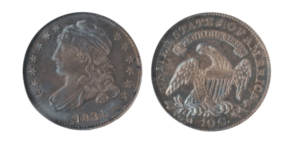
1834 Capped Bust Dime NGC MS64 CAC
Metal: Silver
Year: 1834
Check our most current price here.
Feel free to reach out to Blanchard’s team for any inquiries or a rare coin look-up; they are readily available to assist you with your numismatic questions.
Circulated rare foreign coins to look for
🇨🇦 Rare Canadian coins to look for
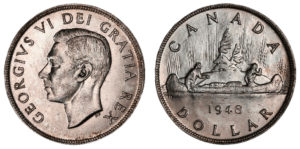 1948 Canada Dollar
1948 Canada DollarCanadian Silver Dollars were minted from 1935 to 1967. First introduced to commemorate the Silver Jubilee of King George V, the coin’s original design featured a portrait of the King on the obverse and a voyageur and Native American on the reverse. Over time, the designs of these coins were updated but always included portraits of reigning monarchs along with symbols of Canadian heritage.
Within the Canadian Silver Dollar series, the 1948 Canadian Silver Dollar edition carries a special and unique status in terms of rare dollar coins to look for. Minted to mark Canada’s centennial celebration of responsible government, a portrait of King George VI by T.H.Paget graces the coin’s obverse, while the reverse boasts a captivating voyageur design by acclaimed artist Emanuel Hahn.
What distinguishes the 1948 Canada Dollar, however, goes beyond its visual appeal. Its allure lies mostly in its historical significance. During World War II, the production of silver coinage came to a halt, as metal resources were redirected toward the war effort. The 1948 Canadian Silver Dollar was the first silver coin issued in Canada post-war, marking a symbolic resumption of normality.
Adding to the coin’s historical significance is the backdrop of India’s independence in August 1947. Preceding this milestone, Canadian silver dollar coins featured the inscription “GEORGIVS VI D:G:REX ET IND:IMP:”, which stood for “George VI By the Grace of God King and Emperor of India.” The transition to new dies reflecting India’s independence resulted in a delay in production in 1948, impacting mintage numbers, which amounted to a mere 18,780 pieces.
The above factors combined enhance the desirability of this iconic coin, making it one of the most special Canadian rare coins to look out for.
🇬🇧 Rare UK coins to look out for
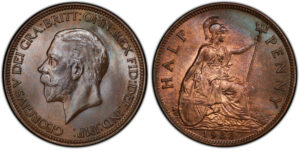 1933 George V ½ Penny
1933 George V ½ PennyBritain stands as a veritable treasure trove for numismatists, offering a rich and diverse array of historical coins that span centuries. Historical British coins tell a tale, reflecting the socio-political changes, cultural shifts, and artistic evolution that have shaped the nation over time.
The 1933 George V Half Penny is no exception. It is a prime example of what makes British numismatics a fascinating field and one of the most rare English coins to look out for if your forefathers had connections to the country.
This special coin was struck in a year that holds a special significance in British numismatics. More specifically, in 1933, the United Kingdom transitioned from using bronze for its coinage to a more cost-effective composition of copper-plated steel. This was due to economic challenges brought on by the Great Depression, which prompted a reassessment of coinage materials and costs.
The change in coinage materials and the general global economic downturn of the times also led to limited mintage numbers, which contributes to the rarity of these coins and makes them valuable for collectors today.
Nevertheless, it is important to note that the halfpenny was demonetized in 1984, and has not been used as legal tender since. This means that, while it may not be one of the most commonly encountered rare British coins to look out for, finding it would take a stroke of extraordinary luck, rendering the discovery exceptionally special.
🇦🇺 Rare Australian coins to look out for
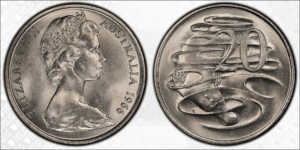 1966 Australian Wavy “2” 20-Cent
1966 Australian Wavy “2” 20-CentCollectors of modern coins and those intrigued by pieces with a distinctive origin may already be familiar with the remarkable and elusive piece that is the 1966 Australian Wavy “2” 20-Cent. A variety of the 1966 London Mint Australian 20 Cent, the Wavy “2” is distinguished by the presence of a wavy baseline beneath the numeral “2”, setting it apart from the standard version of the coin produced that same year.
The distinctive wavy baseline on the 1966 Wavy “2” 20-cent coin emerged during the minting process at the London Mint. While the origin of this peculiar feature is unconfirmed, it is speculated to be a result of an experiment or anomaly in the die preparation. And, as is often the case in numismatics, it is this unexpected and fascinating element to the coin’s design that drives its allure among collectors.
What further contributes to the coin’s “Rare coins to look out for: Australia edition” status is its mintage numbers. Whilst its exact mintage is not precisely known, it is believed to be relatively low compared to the regular 1966 20-cent coins.
The Wavy “2”’s accidental creation, distinct design error, and undisclosed mintage quantity make it a thrilling rare coin to look for in your family’s ancestral vaults.
🇨🇭 Rare coins to look for in Switzerland
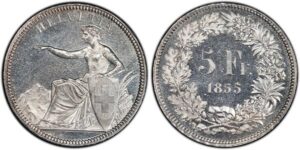 1855 Swiss 5 Francs issued by Solothurn
1855 Swiss 5 Francs issued by SolothurnAs far as rare world coins to look for are concerned, numismatists are bound to be drawn to the allure of Swiss 5 Franc Shooting Thalers. Crafted from the early to mid-1800s through the early 1900s, during a period when shooting festivals held great cultural significance in Switzerland, these coins encapsulate a unique blend of artistic expression and historical context.
Designed by various distinguished engravers, including Antoine Bovy, Friedrich Fisch, and Karl Schwenzer, Swiss Shooting Thalers were crafted to commemorate marksmanship. This is evident by the designs they bear, typically featuring rifles, crossbows, and other imagery related to shooting sports, along with symbols representing the specific canton or region hosting the shooting festival.
Among Swiss Shooting Thalers, the 1855 5 Francs issued by the town of Solothurn is a very special piece, as it held the distinction of being the sole Shooting Festival commemorative coin officially recognized as legal tender. This means that collectors who have a familial connection to Switzerland and are interested in rare silver coins to look for have a chance of coming across one, albeit given exceptional luck.
Another important thing to note about the 1855 5 Francs by Solothurn is that its edge lettering contains a spelling mistake in the word “Freischiesen”. The correct spelling of the word, which translates to “Shooting festival”, is “Freischiessen”. As tends to be the case in the world of numismatics, however, this error only adds to the appeal of this remarkable piece.
How to look for rare coins on Blanchard
While it doesn’t happen often, it is not unheard of for rare coins to hide in plain sight, going unnoticed within the confines of our ancestors’ collections. This adds an intriguing layer to the pursuit of rare pieces and underscores the importance of a discerning eye.
Notwithstanding, collectors do not have to rely on luck but, rather, can look up rare coins and source extraordinary pieces on Blanchard. Refer to Blanchard’s Rare Coins section for further insights into more valuable rare coins.
Want to read more? Subscribe to the Blanchard Newsletter and get our tales from the vault, our favorite stories from around the world, and the latest tangible assets news delivered to your inbox weekly.
The Truth about Bank Bail-Ins: How Safe Is Your Money
Posted onKey Points
- Many big financial companies were deemed “too big to fail” during the 2008 financial crisis. This led to $700 billion in government bank bailouts at taxpayer expense.
- The 2010 Dodd-Frank Act created the framework for bank bail-ins.
- In a bail-in, a bank can take money from their depositors and bondholders to raise capital requirements and keep the bank afloat.
 Bank failures – both big and small – are more common that you think. There were 566 bank failures from 2001 through 2024, according to the FDIC.
Bank failures – both big and small – are more common that you think. There were 566 bank failures from 2001 through 2024, according to the FDIC.
It begs the questions, just how safe is your money in the bank?
While government bank bail-outs were common in the past, policymakers are now turning to a new tactic called the “bail-in,” which allows banks to tap depositor’s funds to increase their capital requirements in a crisis.
What’s the difference: a bail-out vs. a bail-in?
In a bail-out, the government gives money to banks to allow them to continue operations. During the 2008 global financial crisis, the U.S. government bailed out financial firms deemed “too big to fail” like Bank of America, Citigroup and AIG, using a whopping $700 billion of taxpayer dollars.
A bail-in is the opposite. Instead of using taxpayer money, the banks can seize money from their depositors and bondholders to raise capital requirements and keep the bank afloat.
The key difference is who is responsible to keep the bank doors open. Is it the government—using taxpayer money? Or is it the bank—relying on “unsecured creditors,” aka: depositor’s money held in the bank.
Are bank bail-ins legal in the U.S.?
Yes. In 2010, Congress passed the Dodd-Frank Wall Street Reform and Consumer Act, which created legal provisions for bank bail-ins. As part of that legislation, bank depositors are named “unsecured creditors,” meaning their money can be seized to increase a bank’s capital requirements. The goal? To limit the responsibility of the government to bail-out large banks if they fail.
What happened during the 2023 banking crisis?
In March 2023, Americans watched as panicked Silicon Valley Bank depositors rushed to pull their money out of the failing bank. Within 48 hours, Silicon Valley Bank collapsed, marking the second largest bank failure in U.S. history. Soon after, four other U.S. banks went under in a mini-banking crisis for a total of five U.S. banks failures in 2023.
While we didn’t see bank bail-ins happen in 2023, the use of this tactic is being debated for use in the future.
Here’s what the Yale School of Management July 2023 research paper said about the 2023 bank failures: “The FDIC could have saved $13.6 billion in the recent failures of three large banks if regulators had earlier held the banks to the total loss-absorbing capacity”
The tide is turning. And, banks may be forced to do to bail-ins if they face financial trouble ahead.
How you can avoid becoming a victim of the next bank failure.
- Don’t put more than $250,000 in any one bank. FDIC insurance protects the first $250,000 in an account. So, spread your money around between different banks.
- Monitor your bank’s financial situation. If a bank is publicly traded, review the bank’s financial statements on the investor’s relations page. The balance sheet will reveal the bank’s assets/liabilities and whether or not the bank is profitable.
- Keep some of your money out of the banking system. Consider keeping cash in safe deposit boxes or home safes.
- Diversify with physical gold and silver. Owning and diversifying your wealth with physical gold and silver is an avenue to keep a portion of your wealth outside of the banking system. It’s easy to purchase precious metals bars and coins, they are easily transportable, and can be turned into paper money in any country around the world.
Gold and silver have been a store of value for 5,000 years and these highly valued precious metals continue to offers investors today a time-honored vehicle to protect and growth your wealth. It’s no surprise that more and more Americans are turning to the safety of gold today. Have you considered if you own enough?
Read more
Silicon Valley Bank Failure Reminds Us of the Security Gold Provides
Gold Soars As Bank Failures Spark Worries of Larger Crisis
Want to read more? Subscribe to the Blanchard Newsletter and get our tales from the vault, our favorite stories from around the world and the latest tangible assets news delivered to your inbox weekly.
4 Unique Pattern Coins Housed at the Smithsonian
Posted on- 5 Dollars, Pattern, United States, 1865
- 50 Dollars, Pattern, United States, 1877 – The “Half Union”
- 50 Cents, Pattern, United States, 1891
- 5 Cents, Pattern, United States, 1913 – The Buffalo Nickel
The Smithsonian is the largest museum complex on the planet. The United States’ treasured National Numismatic Collection lives within this impressive center at the Smithsonian’s National Museum of American History in Washington D.C.
The National Numismatic Collection includes roughly 1.6 million monetary objects and is believed to be the biggest money collection in the entire world and is unrivaled in its extraordinary collections. Many of its legendary coins are rarely seen.
Some of our nation’s most unique and celebrated pattern coins are protected at the Smithsonian for current and future generations. Pattern coins are those in which the design is struck for the purpose of evaluation only. If the design is approved, only then will the coin be produced for circulation.
All four of the below historic rarities are nestled among the greatest numismatic treasures in the Smithsonian collection in our nation’s capital. Let’s take a look.
1) $5 Dollar, Pattern, United States, 1865
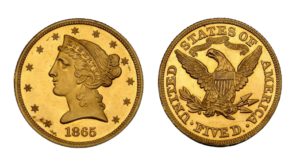
Christian Gobrecht designed the stunning 1865 Half Eagle Gold $5 pattern coin. The obverse features the Lady Liberty facing left. She wears a coronet inscribed LIBERTY. Thirteen stars encircle the coin with the date: 1865 below the bust. The reverse showcases a dramatic eagle with its wings stretched wide with a protective shield covering its breast. The eagle carries three arrows and an olive branch with its talons. The motto IN GOD WE TRUST is on a scroll above the eagle’s head. Only two examples of this pattern were struck and one of them is housed at the Smithsonian.
2) $50 Dollar, Pattern, United States, 1877 – The “Half Union”
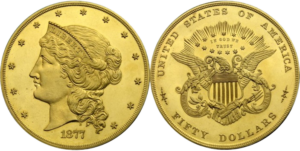
The gold rush in California prompted San Francisco business leaders to lobby congress for gold pieces with high denominations so bankers could quickly count the coins. There were more U.S. pattern coins produced in 1877 than any other year in American history!
Chief Engraver of the mint at the time, William Barber, designed the 1877 $50 Gold Pattern Coin, which is the largest U.S. pattern coin ever struck. This legendary coin was never struck for circulation and the pattern is safely ensconced at the Smithsonian museum for posterity.
3) 50-Cent, Pattern, United States, 1891
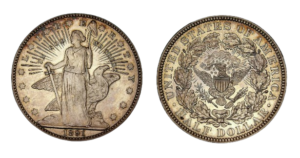
Charles E. Barber, the sixth chief engraver at the U.S. Mint, designed some of America’s most famous and best-loved coins. Barber worked at the U.S. Mint from 1879 to 1917, where he created numerous patterns including two unique 50-Cent Pattern coins in 1891, which are both housed at the Smithsonian’s National Museum of American History.
On the first 50-cent pattern, the obverse features a Capped head of Liberty facing right encircled by stars with the date below. The reverse highlights an Eagle, with stars and clouds above, encircled by an elaborate wreath. On the second 50 cent pattern, the obverse features a full length Lady Liberty facing left, with an imposing Eagle in the background. Rays are seen on the top half of the coin radiating from the center. Notably, some called Barber’s design “cluttered.”
4) 5-Cent, Pattern, United States, 1913 – The Buffalo Nickel
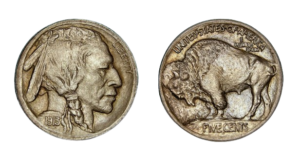
The 1913 Indian Head 5-cent piece pattern is a beloved rarity in the numismatic community, fondly known as the “Buffalo nickel.” Designed by James E. Fraser, the magnificent design on the reverse is instantly recognizable right-facing profile of a Native American man, with a Buffalo on the reverse with UNITED STATES OF AMERICA around the top and FIVE CENTS at bottom.
The memorable Buffalo nickel design was almost abandoned amid protests from the American vending machine industry, who thought the coin wouldn’t work within their machines properly. Fortunately, their concerns were unfounded. The Philadelphia Mint produced this arresting pattern coin in 1913 and while it is currently not on view, it is stored safely at the Smithsonian Museum.
Want to read more? Subscribe to the Blanchard Newsletter and get our tales from the vault, our favorite stories from around the world, and the latest tangible assets news delivered to your inbox weekly.
Looking Under the Hood: What Does LEI Say About U.S. Economy?
Posted onWhen you hear a rumbling noise coming from your engine, you may pull your car over to the side of the road and take a look under the hood. In that same, way, economists and investors monitor many different reports, in order to get a handle on the health of the U.S. economy.

One of those reports is the Conference Board’s Leading Economic Index® (LEI). And look out! That report is making a loud rumbling noise from under the economy’s hood right now.
The latest LEI report revealed that the index dropped for the 21st consecutive month – signaling underlying weakness in the U.S. economy. The length of that negative streak in the LEI report has only been seen before at the start of the 1973 and the 2007 recessions.
Now, this doesn’t mean that history will repeat and it doesn’t guarantee a recession is around the corner.
But its objective evidence that the U.S. economy is slowing and weakening.
Here’s how the Conference Board describes this indicator: “The LEI is a predictive variable that anticipates (or “leads”) turning points in the business cycle by around 7 months.”
Wondering what the LEI measures each month? There’s a lot of parts in this engine! The ten components of The Conference Board Leading Economic Index® for the U.S. include: Average weekly hours in manufacturing; Average weekly initial claims for unemployment insurance; Manufacturers’ new orders for consumer goods and materials; ISM® Index of New Orders; Manufacturers’ new orders for nondefense capital goods excluding aircraft orders; Building permits for new private housing units; S&P 500® Index of Stock Prices; Leading Credit Index™; Interest rate spread (10-year Treasury bonds less federal funds rate); Average consumer expectations for business conditions.
The bottom line is that a time-honored economic indicator is flashing its “Check Engine” light on the economy’s dashboard.
The Federal Reserve is watching the data closely and is prepared to cut interest rates to help support the economy. The Fed already started talking about its plans to cut interest rates at its December meeting.
The Fed’s latest economic projections, known as the “dot plot,” signaled a drop in the Fed’s benchmark interest rate to 4.6% by the end of 2024 (that rate stands at 5.25%-5.50%. now). Some on Wall Street expect even bigger rate cuts ahead.
What does this mean for gold? The lower interest rate forecast is positive for gold and opens the door to a new rising price cycle for precious metals ahead. From J.P. Morgan to UBS to the Bank of America, the big firms all expect new record highs ahead for gold on the back of Fed interest rate cuts this year. With Wall Street forecasts ranging from $2,300 to as high as $2,550 an ounce, the future is bright for gold. While you never want engine trouble, investors who buy gold can help hedge against a “financial” breakdown on the side of the road. Have you considered if you own enough gold for what may lie ahead?
Want to read more? Subscribe to the Blanchard Newsletter and get our tales from the vault, our favorite stories from around the world, and the latest tangible assets news delivered to your inbox weekly.
Gold trades higher, stocks sink after Fed meeting
Posted on — 1 Comment2024 Ushers In New Cycle From Fed 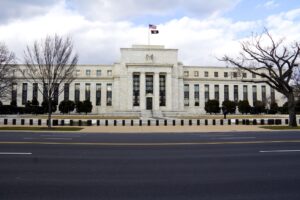
The Federal Reserve held interest rates steady at the 5.25-5.50% range on Wednesday, as expected. The big news out of today’s Fed meeting? The central bankers confirmed widespread expectations that interest rate cuts would be seen in 2024. In the post-meeting press conference, Fed Chair Jerome Powell said rate cuts were likely “at some point this year.”Gold traded higher after the Fed meeting. Meanwhile, stocks fell across the board, in a sea of red as the major stock averages, including the Dow Jones Industrial Average, the S&P 500, the Nasdaq Index and the Russel 2000 all showed losses on the day. U.S. Treasury bond prices also fell.Stocks skidded even lower during the Fed’s post-meeting press conference as Powell warned: “We still have ways to go on achieving a soft landing” referring to uncertainty about the economy ahead. The Nasdaq and S&P 500 were both down more than 1%.Timing of Rate Cuts are UncertainHowever, with inflation still above the Fed’s 2% target, the central bank made no promises on the exact timing of interest rate cuts. “The committee does not expect it will be appropriate to reduce the target range until it has gained greater confidence that inflation is moving sustainably toward 2%,” the Fed’s statement said.The most recent Consumer Price Index (CPI) report showed that inflation remains higher than the Fed would like, at a 3.4% annual rate.A key concern for Fed policymakers is that inflation could settle in and stabilize at a rate above the Fed’s desired 2% target rate. While inflation has come down from its 9%+ peak, getting the consumer price increases down to the 2% mark could be challenging, as economists have warned for months.Gold Attracts Fresh Safe Haven BuyingInvestors turned to gold Wednesday afternoon, as fresh safe-haven buying boosted the precious metal higher, while stocks and bonds fell. Physical demand for gold has been strong in recent months as gold climbed from its October low at $1,822.70 to above the $2,000 level currently.Fed interest rate cuts are expected to continue to boost gold prices higher throughout the year. Indeed, many Wall Street firms forecast gold will hit all time gold for 2024.A new cycle for the Fed begins, which brings the value of gold into strong focus. For thousands of years, gold has served as a store of value, a tangible asset to preserve and grow wealth – and that role has taken on new importance in our economy today as inflation continues to erode the value of paper money. Is it time for you to trade some of your paper money for gold? Call your Blanchard portfolio manager today if you have questions about where the economy is headed and what it could mean for your wealth. We’re here to help.
Want to read more? Subscribe to the Blanchard Newsletter and get our tales from the vault, our favorite stories from around the world, and the latest tangible assets news delivered to your inbox weekly.
The 2024 U.S. Economic Outlook and What It Means for Gold
Posted onLooking back, 2023 may well be remembered for the recession that never happened. But, looking forward into 2024, what is the economic forecast for the coming year and what could it mean for gold?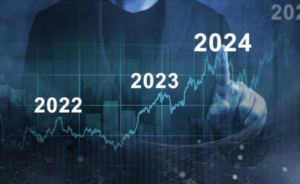
Many hope that 2024 will be the year of the “soft landing” for the U.S. economy. Just like Goldilocks and her porridge a soft landing would mean the Federal Reserve handles inflation and interest rates “just right”—and the economy emerges not too hot and not too cold. The Fed is walking a tightrope and needs to thread a needle to succeed. Let’s explore some of the dynamics at play.
The Consumer Makes the U.S. Economy Go Round
When you buy a home, the mantra in real estate is location, location, location. When it comes to the U.S. economy, the consumer is the primary engine for growth. After all, consumer spending makes up nearly 70% of Gross Domestic Product (GDP). Yet…
Americans Take on More Debt
While the economy continued to grow and Americans kept buying in 2023, they did so using borrowed money. In the back half of 2023, the U.S. personal savings rate fell from 4.9% to 3.8% by end of the year.
So, as Americans saved less, they continued spending, and racked up more credit card debt, which climbed above $1 trillion—all all-time record high in 2023. While the spending keeps the economy growing for now, Americans are seeing their unpaid bills pile up, and they will eventually face a reckoning.
Inflation Is Lower: But the Fed’s 2% Target May Remain Elusive
The Consumer Price Index (CPI) closed out 2023 with a 3.4% annual increase, which marks progress from the Dec. 2022 CPI reading at 6.5%. The road to target 2% inflation has been a long and bumpy ride for the Fed, and the journey isn’t over yet. The so-called “last mile” of the inflation fight could be the hardest—returning to the 2% level—especially with interest rate cuts in the forecast for this year.
Slowing Growth
Wells Fargo has removed a recession forecast from its 2024 outlook, but nonetheless, economists there estimate the probability of a U.S. recession remains at roughly 40%.
J.P. Morgan economists forecast that U.S. growth will slow to 0.5% by the second quarter of 2024, which will force the Fed’s hands to begin cutting interest rates. The reasons? The impact of monetary policy (high interest rates) will take a bigger toll, and the post-pandemic tailwinds will fade, they say.
Interest Rate Cuts Ahead
The slowing U.S. growth will force the Fed’s hands to lower interest rates, even though inflation still remains above target. The central bank will begin to slash interest rates to help prevent a potential recession.
By how much and when? Wells Fargo projects that the Fed will cut its target range by 125 basis points by the end of 2024 and by a total of 225 bps by the end of 2025. The firm expects the first rate cut of the easing cycle will occur at the May 1 Fed meeting.
The 2024 Washington Wildcard
Last but not least, looming on the horizon later this year, is the 2024 November presidential election. A contentious battle for the White House is already heating up, and Americans can expect an advertising blitz from both parties. In the midst of this, the divided government could result in a shutdown. Other key policy risks lie the U.S. deficit, which continues to expand and government spending, which will keep markets uncertain and demand for gold high.
Gold Poised for More Record Prices in 2024
Gold was one of the top performing asset classes in 2023, climbing 14.6% on the year. Gold’s performance beat other commodities, bonds, cash, and emerging stocks. The key drivers for the strong gold performance last year included persistent central bank buying, robust retail demand, and increased geopolitical risk which drove fresh safe-haven buying of the metal.
Looking into 2024, gold is expected to benefit from falling U.S. interest rates, slowing U.S. growth and a weaker U.S. dollar. Economic and geopolitical uncertainty are expected to keep demand for gold high in the year ahead, as investors trust in the precious metal’s ability to act as a reliable store of value and protect wealth. Its low correlation to other asset classes like the stock market means gold can act as insurance during down stock markets and other geopolitical events and crises.
How high can gold climb? J.P. Morgan forecasts new record highs for gold, with prices reaching $2,300 an ounce by 2025. Other firms agree that fresh gains are ahead for gold. UBS strategists predict that gold prices could close out 2024 as much as 10% above late January price levels on the back of potential interest rate cuts. “Ongoing macro and elevated geopolitical risks continue to justify holding exposure to gold for hedging and diversification purposes, in our view,” UBS said.
Are your finances prepared for what may lie ahead? Call Blanchard today for a personalized portfolio review and take action to protect and grow your assets in the year ahead.
Want to read more? Subscribe to the Blanchard Newsletter and get our tales from the vault, our favorite stories from around the world, and the latest tangible assets news delivered to your inbox weekly.
Coin Investment Psychology Explained
Posted onWhile investment may be all about making a profit, there’s a lot more to it than numbers. In fact, some would argue that the psychology of investing is even more pivotal to success than figures. This piece will explore basic coin investment psychology and arm you with the best tips for making lucrative investments. Read on to learn about:
- The concept of investor psychology.
- The emotional factors that commonly affect investment decisions.
- The best place to buy bullion for investment online.
To delve deeper into our topic, watch this interesting video about the role of human psychology in investing:
What is the psychology of investment all about?
Investor psychology is a branch of behavioral finance that studies the emotional and cognitive factors that influence the decision-making process of investors. It supports that market decisions are not always rational. Instead, they are often driven by a complex interplay of sentiments and psychological heuristics.
The science of investor psychology examines how human emotions like fear, greed, and overconfidence, coupled with cognitive biases, impact investment choices. It also explores phenomena such as herd behavior and loss aversion, shedding light on how these subconscious inclinations can lead to market bubbles or crashes.
By understanding and addressing the psychological aspects of investment, individuals can make more informed, less impulsive decisions, and potentially enhance their financial well-being in an unpredictable financial landscape.
Emotional investment: psychology factors influencing your behavior as an investor
When it comes to the psychology of investing, knowledge is power. Understanding prevalent emotional drivers that shape decision-making empowers individuals to make strategic and successful investment choices. Without further ado, here are the most common psychological factors that influence investors’ behavior.
1. Herd mentality is one of the phenomena studied by investment psychology
Herd mentality, also known as sheep mentality, is the human inclination to follow the crowd. A common behavioral phenomenon, it has been extensively explored by investment psychologists. Their work has shed a lot of light on how and why individuals tend to base their choices on the actions and opinions of the masses.
Applied to the world of finance, herd mentality, driven by mass emotions of fear or euphoria, can lead to the formation of market bubbles and precipitate dramatic crashes. Some prime cases in point include the dot-com bubble of the late 1990s and the 2007-2008 housing bubble. Investors who understand the dynamics of herding are less likely to succumb to the irrational exuberance of a market bubble or the collective panic of a market crash.
💡 Expert Tip: Herd mentality is a tale as old as time. While it’s unlikely to stop occurring any time soon, you can use knowing about it to your advantage! According to some of the best councils about investment psychology from great financiers, to avoid falling victim to herd mentality, you should always conduct your independent research.
2. One important psychology investment model talks about the fear of regret
Regret theory, a central model in psychology and investing, delves into the profound impact of the fear of regret on investment decisions. The model recognizes that investors often make choices not only based on the expected financial outcomes but also considering how they will feel about their decisions in the future.
The fear of regret stems from the apprehension that an investment choice might lead to negative emotions like remorse or self-blame. Most commonly, it leads people to opt for safer, more conventional investments, even if the potential for higher returns exists elsewhere.
Investment psychology explores strategies to mitigate the fear of regret, promoting rational decision-making and a better balance between risk and reward.
💡 Expert Tip: The key to investing in the assets you want without regretting it later is diversification. Spreading your investments across different assets can reduce the impact of a single investment’s potential poor performance, so there is no need to be afraid!
3. Loss aversion is a big theory in the psychology of investing
As far as investment theory psychology is concerned, loss aversion is one of the most prominent paradigms. Closely related to the aforementioned fear of regret theory, the concept of loss aversion posits that people feel the pain of losses more intensely than the pleasure of gains. In practical terms, it means that investors are often inclined to be overly cautious to avoid losses, even when the potential for gains is significant.
Loss aversion can lead to suboptimal choices, preventing people from reaching their full investment potential. Investment psychology extensively studies this phenomenon to understand its implications and develop strategies to manage it effectively.
💡 Expert Tip: Focus on your long-term investment strategy. Adapt your perspective to see losses as minor bumps along the way that ultimately will not prevent you from reaching your destination.
You don’t need to worry about loss aversion when you invest in classic silver coins like this one:
- Country of origin: United States
- Metal: Silver
- Fineness: .999
Check our most current price here.
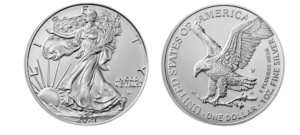
Do you prefer more weighty silver investments? Then how about one of these high-quality bars?
- Country of origin: Varies
- Metal: Silver
- Fineness: .999 or .9999
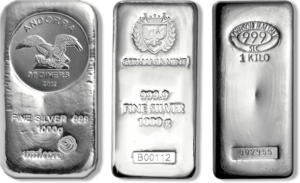
4. A major element in investing psychology is confirmation bias
Confirmation bias has been the downfall of many investors. This bias refers to the tendency to seek and remember only the information that aligns with our pre-existing beliefs. In the context of investing, confirmation bias can lead to a skewed perspective and poor investment decisions.
Recognizing the presence and impact of confirmation bias is essential for investors. To make successful and profitable investment decisions, it is important to maintain an objective approach, taking into account recent and accurate financial data.
💡 Expert Tip: Before investing, always examine your fundamental convictions. Ask yourself whether you are basing your decisions on the psychology of previous investment successes or if you are looking at a fresh situation objectively.
5. The psychology of investment studies mental accounting behaviors
Mental accounting is basically compartmentalizing. People do it all the time to facilitate various aspects of their lives, from managing home organization or work-life balance.
As you’d have it, investing is no exception. Many people have the automatic instinct to compartmentalize investments in their heads. Dividing assets into good and bad based on previous experience and other factors can help investors mentally navigate the financial landscape.
However, mental accounting can seriously affect investor psychology and investment decisions. This can happen in many different ways, including hesitating to sell poorly performing assets because they’re in the “Good” box thanks to past gains. It is important to remember mental accounting isn’t always helpful and can hinder profitability.
💡 Expert Tip: Use specialized financial software to view your overall financial picture before you invest. This will help you avoid the trap of compartmentalizing and ensure that your investment decisions align with your broader financial goals and strategy.
6. Rusbult’s close relationship model can be applied to investment psychology
Does the phrase “Rusbult investment model psychology” ring a bell? Caryl E. Rusbult was a social psychologist who talked about the three factors that influence the stability of romantic relationships in what is known as the “close relationship model”. These factors are commitment, satisfaction, and alternative options.
Surprisingly, this underlying principle can be a valuable framework for understanding the emotional factors that influence investments. Individuals may become deeply committed to a specific investment, even when it no longer serves their best interests. Similarly, a satisfied investor may become complacent with their current investments. Another who believes they have no alternative choices may be willing to buy risky assets. See where this is going?
💡 Expert Tip: Maintain an unemotional approach when it comes to investments. Regularly viewing your portfolio with a critical eye and setting clear financial goals will help you do that.
Do you have a hard time keeping your cool when you see beautiful gold coins like this one? We get it!
1 oz Austrian Gold Philharmonic Coin
- Country of origin: United States
- Metal: Gold
- Fineness: .900
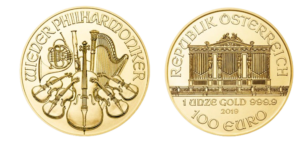
If you’ve got the psychology investing down to a T, see more coins here.
Do you prefer gold bars to coins? This Swiss piece is a remarkable one:
-
- Country of origin: Switzerland
- Metal: Gold
- Fineness: .9999
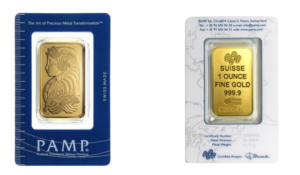
7. Prospect theory affects investor psychology and investment decisions
How does the psychology of the typical person affect investment returns? Prospect theory takes a good swing at answering that. A seminal concept in the field of investment psychology, developed by Daniel Kahneman and Amos Tversky, prospect theory suggests that people are risk-averse when it comes to gains and risk-seeking when faced with losses. They prefer certain gains over uncertain ones, even if the latter could offer higher expected value. In contrast, when facing losses, individuals tend to become risk-seeking, often taking gambles to avoid a sure loss, even if the gamble is riskier.
As would be expected, this leads to suboptimal investment behavior. It makes investors hold onto losing assets hoping for a recovery, or conversely, selling assets prematurely to secure gains.
💡 Expert Tip: If you suspect you could be influenced by prospect theory, seek external advice. Before buying or selling assets, talk to a professional who can offer objective investment guidance.
8. Investment psychology explained: delving into overconfidence bias
Let’s face it: we all know an overconfident, cocky person who thinks they know it all. While this can be annoying, it usually doesn’t pose a big problem. Unless it comes to investing, that is.
In investing psychology chart explanations, the overconfidence bias is described as a psychological phenomenon that stems from an individual’s tendency to overestimate their own knowledge, skills, and judgment. It can lead to unwarranted risk-taking and a failure to recognize potential pitfalls, ultimately impacting investment decision-making.
💡 Expert Tip: The only antidote to overconfidence is education. Read some of the top investing books of all time and learn everything you need to know about investments!
9. Emotional investment psychology explores anchoring behaviors
Another cognitive bias that can influence investment choices is anchoring behaviors. In investment psychology, this refers to when investors assume that the market price is the correct price. They fixate on some information as a reference point that they use to “anchor” their decisions. This, of course, can lead to biased judgment.
Understanding anchoring is vital for investors, as it highlights the need to critically assess financial information and avoid being unduly influenced by arbitrary references.
💡 Expert Tip: Do your research prior to investing to ensure you’re not anchored to past prices or misinformation. This can be especially useful if buying items at auction!
10. An investment model psychology talks about is plasticity
Last, but certainly not least, is the powerful concept of plasticity. This basically means the capacity of investors to adapt, learn, and change their financial behaviors, responding to changing market conditions. This cognitive flexibility is integral to investor psychology and investment decisions that are rational. It enables individuals to adjust strategies in response to market shifts and learn from past experiences, fostering improved financial outcomes.
The concept of plasticity is important because it suggests that investors can overcome biases and make better choices by actively working on improving their investment skills.
💡 Expert Tip: Have faith in the concept of plasticity! By trusting in your capacity to evolve and refine your strategies over time, you can become a more adept investor.
Got the skills and just need a great investment to match? This meticulously crafted platinum coin could be it:
- Country of origin: United States
- Metal: Platinum
- Fineness: .9995
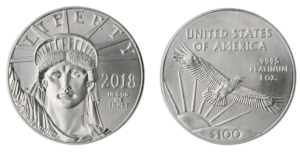
Time to apply your knowledge of investing psychology!
Emotional and cognitive factors can have a significant impact on investment decisions. Mastering the world of investing is not just about financial expertise. It also demands a keen awareness of the emotional undercurrents driving market decisions.
To start your investment journey, head to Blanchard. There, you will find a wide selection of precious metals coins and bars at the most competitive prices!
Something on your mind? If you still have doubts about investing in bullion after reading this piece on the psychology of investment, check out our “Why invest?” section here.
Want to read more? Subscribe to the Blanchard Newsletter and get our tales from the vault, our favorite stories from around the world, and the latest tangible assets news delivered to your inbox weekly.
Existing Home Sales Sink Over 18%: What This Means For Gold
Posted onWith 30-year fixed mortgage rates topping the 7% mark, it’s no surprise the housing market has ground to a halt. Existing home sales plunged 19.3% through the first eleven months of 2023, versus the same period last year, according to the National Association of Realtors.

Slowing home sales hurts more than just buyers and sellers, however. The housing market slowdown has a ripple effect throughout the entire economy, impacting consumer spending and even the labor market. And this, in turn, has positive implications for gold in 2024.
Low Inventory, High Prices, High Mortgage Rates
Wannabe home buyers have seen one of the most challenging housing markets in years, as the Federal Reserve’s interest rate hikes triggered a sharp jump in mortgage rates in 2023.
The Fed rate hikes created a scenario where would-be home sellers decided to stay put and not even put their homes on the market. Many current homeowners refinanced mortgages in recent years and have ultra-low mortgage rates, which they weren’t eager to trade in for a sharply higher mortgage rate if they moved.
So, home buyers across the country face a low inventory of available homes for sale. There were 1.13 million homes on the market by the end of November, the National Association of REALTORS® said. Before the pandemic, there were roughly twice as many homes on the market.
In turn, the low inventory situation pushed home prices higher. The higher home prices, combined with the higher mortgage rates ultimately priced many potential home buyers out of the market in 2023.
Housing’s Impact on the Economy
The housing sector has a surprisingly large impact on the overall U.S. economy and also has implications for the direction of the gold market in 2024.
Consider this: when someone buys a new home, they also typically must furnish that home with new sofas, dining tables, curtains, maybe even new appliances, patio furniture and a snow blower or lawn mower. The spillover impact is larger than you might expect.
During the first year after closing on a house, a typical buyer of a newly built single-family detached home spends, on average, $9,250 more than a similar non-moving homeowner, according to the National Association of Home Builders. A 2021 NAR study estimated that the housing market generated a median of about $113,000 in economic impact per home sale.
What about the job market? Here’s what the Wall Street Journal said on Dec. 19: “Less spending on housing means less need for workers in industries that are closely tied to the real-estate market, including at retailers for furniture and electronics, and at home-improvement stores. Employment is down across those industries this year.”
The bottom line? When home sales plunge, like we saw in the first eleven months of 2023, it’s a drag on the economy and consumer spending.
What Does This Mean for Gold?
The U.S. economy is estimated to slow down in 2024, with some firms even forecasting a mild recession. The Conference Board currently projects an overall gross domestic product (GDP) rate of 0.9% in 2024, down from 2.4% in 2023. However, other firms including bond giant PIMCO, Deutsche Bank, Vanguard, PNC and LPL Financial all expect a mild recession to emerge in the U.S. in 2024.
A slowing economy will open the door to higher gold prices ahead. As the economy slows down or falls into recession in 2024, the Fed will be forced to slash interest rates to remove the tighter monetary conditions. That will open the door for a run to new all-time highs in gold.
Indeed, JP Morgan expects a series of interest rate cuts between the second half 2024 and the first half of 2025 which they say could lift gold to $2,300 an ounce. Bank of America is even more positive on gold: they predict if the Fed slashes interest rates in 2024, that gold could climb to an impressive $2,400 an ounce in the New Year.
Gold set a new all-time high in 2023. Investors can expect new record highs again in 2024. Is your portfolio set up to benefit from the rising trend in gold? If not, explore options like gold coins, fractional coins or gold bullion bars today.
Want to read more? Subscribe to the Blanchard Newsletter and get our tales from the vault, our favorite stories from around the world, and the latest tangible assets news delivered to your inbox weekly.
Can I Buy Gold and Silver for My IRA?
Posted onSaving for retirement through an individual retirement account (IRA) has many benefits, which are widely known. What is not as commonly known is that you can invest in physical assets like gold or silver bullion inside an IRA account.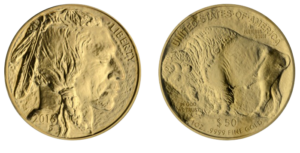
Investing in physical gold within an IRA account has many benefits including diversification. As an investment, gold is considered a portfolio diversifier and offers you the opportunity to preserve and grow your wealth, especially when other asset classes aren’t performing well.
If I want to invest in gold or silver in my IRA, can I store the bullion in my home?
No. You will need to open a self-directed IRA account with an IRS-approved custodian bank to add gold to an IRA. Blanchard has a longstanding relationship with GoldStar Trust Company, but we’ll gladly help you get started with any IRS-approved custodial institution you choose.
With a self-directed IRA, you can invest in a wide variety of precious metals including gold, silver, platinum or palladium. However, the IRS has specific criteria your precious metals must meet.
What is IRA-eligible gold and silver, platinum and palladium according to the IRS?
These are the minimum “fineness requirements” for precious metals that are set by the IRS in order to be IRA-eligible gold, silver, platinum and palladium. These include:
- Gold: .995 fine (Gold American Eagle is the only exception)
- Silver: .999 fine
- Platinum: .9995 fine
- Palladium: .9995 fine
Wondering how to get started?
Follow these three steps to open a precious metal IRA
Step 1: Open Your Account. You can easily roll over an existing IRA or 401(k) or open a new precious metals IRA.
Step 2: Transfer Funds. You can choose an investment amount you would like to rollover and transfer funds from your existing IRA, 401(k), or TSP account. The transfer or rollover process is tax and penalty free.
Step 3: Choose Your Metals and Fund Your Account. Examples of IRA approved gold and silver include the following:
- 1 oz. American Gold Buffalo
- 1 oz. Australian Gold Kangaroo Coin
- 1 oz. Austrian Silver Philharmonic Coin
- 10 oz. Silver Bullion Bars
- 100 oz. Silver Bars
- 1 oz. Canadian Gold Maple Leaf Coin
- 1 oz. Austrian Gold Philharmonic Coin
- 1 oz. Gold Bar
- 1 oz. American Platinum Eagle
How much can you contribute to a self-directed IRA?
The IRS contribution limits for a self-directed IRA are the same as a traditional IRA and you will enjoy the same tax advantages. For 2024, the limit on annual contributions to an IRA increased to $7,000.
Build a secure future with a self-directed IRA
Before you add your hard earned savings to a typical IRA that invests in mutual funds, exchange traded funds, bond funds or cash, consider this. Those are all paper assets. Confidence in the stock market is on the decline. History demonstrates that gold is uncorrelated with the S&P 500. That simply means when the S&P 500 plunges, gold typically moves sharply higher. That makes gold an excellent portfolio risk diversification tool and an ideal investment for a self-directed IRA. Adding gold to your IRA portfolio is a form of wealth protection in a tax-advantaged retirement account.
Get started today
It is a relatively easy process to transfer some or all of your current IRA to a retirement plan custodian that specializes in tangible asset investments. Using an IRA to buy physical gold retains the tax advantages and offers you the potential for capital appreciation and inflation and purchasing power protection over time. If you are looking for an opportunity to add an additional layer of diversification into your investment strategy, a self-directed IRA could be right for you.
Questions? We are here to help. Call Blanchard at 1-800-880-4653. Or learn more about adding precious metals to your IRA here.
Want to read more? Subscribe to the Blanchard Newsletter and get our tales from the vault, our favorite stories from around the world, and the latest tangible assets news delivered to your inbox weekly.








